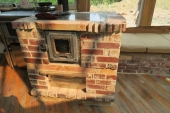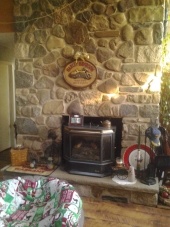Hi all.
Thank you for adding me to the forum!
I am currently 3 months into a year living as much as I can off the land, foraging for all my food, plus as much of my living needs as possible (hut, clothes etc). See Nicola's Year on the Land Podcast
webpage
I plan to build a stove and chimney into my hut (which has wattle and daub walls & a grass roof) asap, as the British winter is pretty wet and cold enough!
I am limited in materials to what I can reasonably collect around me- so clay, sawdust, grass. Only beach sand which I gather isn’t useful for building.
I’ve put together a stove design which I hope use for cooking and heating. I’ve tried my best to understand the principles involved but am definitely unaware of some of them! Hence, I’d love comments/suggestions from ye wise ones. The stove and chimney represent a massive amount of work (collecting/processing materials, building) and I am relying on them for getting through the winter- so I need a design highly likely to work. I also need to get cracking as I’ll need a couple of months for the whole thing to dry out.
The 1st two pics are schematic diagrams of the front & plan views. Apologies for the quality, I was in my hut without a ruler. The 3rd pic depicts the proposed materials & the 4th an alternative shape to the bell.
J-tube
I was planning a 5”diam round j-tube made with clay and sawdust. I can prefire this in my updraft kiln. The dimension of the tubes are 1:2:4, based on the centre lines.
Above the riser, there’s a hole cut for a pot (lorena style) plus a shaping so I can place a thick (2”) piece of granite over the hole when not cooking. (see bottom pf pic 1 for detail on this).
Bell
The heat flow is then channelled down an insulated (clay/sawdust) 5” channel down onto a bell, to extract heat from the gases. I was thinking of making the bell from 40% earth, 40% clay & 20% grass. The grass for strength, the earth as thermal mass (would it be?!).
I’ve estimated the bell to need an ISA of 34 square feet. This is based on Peter’s calculations for 6/7/8” systems. I had to estimate as I couldn’t understand how to calculate the ISA for 5”s. Happy to be shown how!
Pic 4 gives an ideal shape for the bell, based on the hut space (small!) & the materials- this would be low, narrow & long. My understanding though is that tall and narrow is better for a bell?
I also wondered if I put a door into the bell, I could use it for cleaning plus access to bake in the bell? I’m not sure that the materials I have would allow regular access without crumbling.
Chimney
I am currently making some 5” clay pipe sections for the upper parts of the chimney, which will be fired. These will make the parts of the chimney which could get wet (through the thatch, outside).
I was thinking of making the lower parts of the chimney from a clay/grass mix. But would it be better for this section to be insulated with sawdust too?
Of course, I could make more pipes with the clay/sawdust mix, so the whole chimney is insulated, if this would be better.
Configuration
At the bottom of pic 2, I suggest a different layout for the components. I don’t think this makes any difference to the suitability of the design...
Materials
Am I using what I can get to it’s best use?
Perhaps the walls will need to be thicker? I’m balancing the work to gather with the system being strong enough to last 9 months.
1. Front view
 https://imgur.com/KUux5xL
https://imgur.com/KUux5xL
2. Plan view
 https://imgur.com/IPRBvBh
https://imgur.com/IPRBvBh
3. Materials
 https://imgur.com/5MrSLBH
https://imgur.com/5MrSLBH
4. Bell shape
 https://imgur.com/fkSDb3W
https://imgur.com/fkSDb3W
 4
4









 5
5




 3
3





 3
3





 5
5




 4
4




 1
1





 5
5





 5
5




 2
2





 4
4




 2
2









 2
2




 1
1









 3
3




 2
2









 2
2




 1
1









 2
2











